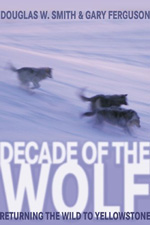Review of "Decade of the Wolf: Returning the Wild to Yellowstone"

Author(s): Douglas W. Smith and Gary Ferguson
Published: April 2005, The Lyons Press, ISBN: 159228700X
 by James A. Huggins, Ph.D., University Professor & Director of the Hammons Center for Scientific Studies
by James A. Huggins, Ph.D., University Professor & Director of the Hammons Center for Scientific Studies
June 158, 2005 -
Wolves once were spread across the North American continent from coast to coast. In the United States it took only a couple hundred years for us to drive them to all but extinction in the lower forty-eight states. The last wolf had been killed in Yellowstone in 1926. It was Aldo Leopold who first called for the reintroduction of wolves into Yellowstone National Park. Remarkably, this recommendation was made in 1944 and, in my opinion, speaks to the tremendous insight this man possessed. His proposal didn’t have a ghost of a chance at that point in history but a new day had dawned. In 1994 history would record that the folklore surrounding these predators had drifted away from the “big and bad” personification to one that recognized the more admirable qualities of these creatures. Despite the fact that the wolf was, and still is, virtually an icon for every thing that represents the wilderness, reintroduction was a monumental task on many fronts. First and foremost, and despite the fact that a poll taken by Colorado State University showed that between 75 and 82% of Americans favored the reintroduction of the wolf, it was a political “hot potato” within the states that were to receive the “gift” of this top carnivore. It must have been something akin to the problems that erupt within a community when they learn that the new but desperately needed correctional facility in going to be located in their backdoor. The project holds intrinsic value but the risks are too great for many to even begin to entertain the thought. This was especially true for the ranchers of the area and for the hunters that feared a reduction in game in general and the elk herds in particular.
This book shares the reintroduction plan from its inception and demonstrates that the plan was obviously well thought out. There were thirty-one adult wolves over two seasons taken from different regions in Canada; then acclimated in holding pens for ten weeks. The advantages to this include: members from the same pack were captured and released together to insure a ready-made social structure, these animals already knew how to hunt and, by taking them from different regions, genetic diversity was established across the Yellowstone population in anticipation of the formation of new packs during colonization of the park. They even chose which packs from Canada these wolves would come from in order to take advantage of the wild canid’s “search image” that is established early in life by the prey types they have been taught to hunt. In this case, wolves were needed that would hunt elk as this would be their primary prey item in Yellowstone. To be sure they do learn to hunt other animals. In fact, Yellowstone wolves feed on moose, bison, mule deer, and beaver and, to a much smaller extent, upon white-tailed deer, bighorn sheep and mountain goat. In the summer small rodents form a small percentage of their diet as well.
Smith and Ferguson relate many interesting facts concerning wolf biology and reveal a number of “firsts” or variations from what was considered normal that have been associated with the Yellowstone studies. Most of the readers will likely be shocked to learn that the average Yellowstone wolf only lives to be 3.4 years of age, that there is 1200 lbs per square inch (psi) of crushing power in the bite of a wolf compared to a mere 600 psi for a large dog, that gestation averages 63 days with pups being born in April, that only one out of every five attempts to bring down prey is successful, and that some of the larger males may reach 130 lbs. Some firsts or aberrations noted over a decade of studying these animals include: the first time that subordinate members from the same pack have killed an alpha female and it was the first time that 10 month old females have been recorded to be breeding. While other packs in distant locales have shown little propensity for producing multiple litters, i.e. females other than the alpha female producing pups, it is not uncommon at Yellowstone. These additional litters may have been sired by the alpha male or by males from other packs. It is an interesting fact biologically to note that pack size tends to vary with prey size. The larger wolves and the larger packs tend to be those that harvest bison and the smaller the prey size the smaller the pack. For those predators that hunt alone it is typically individual size that varies with prey size. My own doctoral dissertation with shrews illustrated this point as have numerous other studies across vertebrate predator populations. While it does appear that individual size in wolves responds similarly (bigger wolves found in packs that hunt larger prey), it also seems that, in this case, the “social” construct may also be responding to the pressures exerted by prey size in a similar fashion. Other interesting and instructive topics for the student of biology found in this book include: territoriality, dispersal, trophic cascades, apex carnivores, consumers, decomposers, riparian zones, surplus killing, compensatory and additive mortality, denning behavior and rendezvous sites.
It doesn’t seem possible but it has been ten years since the reintroduction of wolves into Yellowstone. I remember it as if it was yesterday. It was, to be exact, the year that I came to serve on Union’s main campus from the Memphis campus which was then associated with Baptist Hospital of Memphis. While much has changed during this interlude, much remains the same. I guess it wasn’t too surprising to find that the issue of wolves is still a divisive one. Law suits to end the protection of these animals as they begin establishing ranges off the park and suits to keep their status as endangered species are currently underway. But the park, the researchers and the community have changed from this grand experiment. The park and the community are now the recipients of 20,000 people from around the world travel to see wolves at the park every year and ecotourism pours an estimated $23,000,000 annually into the local economy. The researchers have grown as scientists and in their humanity as they have monitored every conceivable aspect of their charges. The portions of this book that elaborate upon the individual lives of the wolves, entitled “wolf portrait”, that were the major players, often the “founders” of the Yellowstone population, are an excellent touch. Wolf “groupies” have been known to cry at the reported deaths of some of the “wolf stars” embedded in this story. It is easy to become anthropomorphic as one reads of these unique and individual personalities and their simple but vital stories as recorded by their researchers. For instance, one wolf, designated number 9 (remember she is only one of thirty-one originally released), via genetic analysis, was shown as of 1999, to be related to 79% of all Yellowstone wolves. Her legacy is secure and the Canadian trapper who brought her in should get a bonus.
The chapter on “The wolf effect” is perhaps the most fascinating, at least for a professional biologist, of all. I was spellbound as the authors expounded upon the “changes” the reintroduction had imposed upon the ecosystem of the area. Of course, this is the ecosystem as it was before man removed that top carnivore. The existence of this long time absent top carnivore has altered the behavior and feeding patterns of the elk and research has indicated that many plant species have been “released” from overgrazing and are flourishing as they once did decades ago. Beaver have followed the increased availability of willow and through their engineering feats have produced ponds that now support many riparian species that have found little habitat in the decades previous to the wolf. Just as remarkable has been the information that has come from the studies concerning those species that profit from the kills that are made by wolves. Unlike the grizzly and the cougar, Canis lupis does not cover his kills or defend it from scavengers so vigorously. Consequently, there is “food for the masses”. It has been determined that 12 different vertebrate species use prey killed by wolves. Even the mighty grizzly profits from the presence of the wolf in that he is able, especially during times of hardship, to find a quick and relatively easy meal by absconding a pack kill. It is true that elk populations, the primary prey item, have diminished in numbers but other species have benefited from their presence. Another species, the coyote, has also diminished in number but their population density, as are those of the elk, are healthy and are perhaps more in line with those of previous years. For instance, red fox, rodents and pronghorn fawn benefit from fewer coyotes. An increase in the rodents may even lead to an indirect increase in the number of raptors. The preliminary research seems to indicate that the diversity wolves help support creates a healthier, more resilient ecosystem. It is refreshing to think that rehabilitation of ecosystems, something that many of us dream about for our planet, may actually be possible.

